Revell 1/32 F4U-1D Corsair
By Mark Proulx

The Japanese called it "Whistling Death". For those of you fortunate enough to hear the F4U Corsair in flight, there could not be a more suitable name.
First released in 1970, Revell's 1/32 scale Corsair is still available on the shelves today. This proves its consistent popularity with model builders everywhere. The kit has been released with a number of different decal options and even a rare Fleet Air Arm clipped wing variant. Now, at last, aftermarket producers have taken notice of this and we are seeing a number of sets released to update this model. Black Box and Lone Star Productions have released superb resin detail sets for this kit. Unfortunately, the only sets available for me at the time of construction came from Eduard and Marine Air Products.
The kit of choice for this project is the F4U-1A released by Revell of Germany. It has remained true to its earlier release with the only changes being the markings supplied for two aircraft. The first, an F4U-1 flown by Lt. Merl W. Davenport of VF-17 fame. The second aircraft is in the markings of a Vought Corsair IV from HMS Colossus.
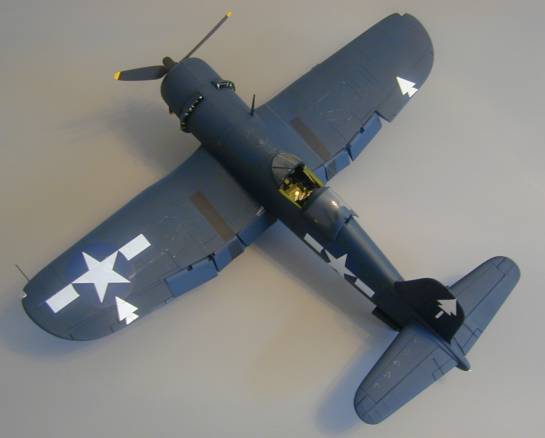
The aircraft as molded is basically a mix of F4U-1A and 1D components. On the plus side for this model, the overall outline of the kit is very good and the wings have a good representation of the fabric covered outboard wing panels. Even the vertical stabilizer has its proper 2 degree offset! However, the surface detail is marred by its oversize raised panel detail. The cockpit detail is poor, as is the representation of the cowl flaps. The engine sticks out to far from the cowling and the landing gear wheel wells are not boxed in. The leading edge air intakes will also require some work to bring it up to acceptable levels.
First, all surface detail is sanded off and rescribed using available references. Working from the front to rear we now start what turns out to be a huge undertaking.
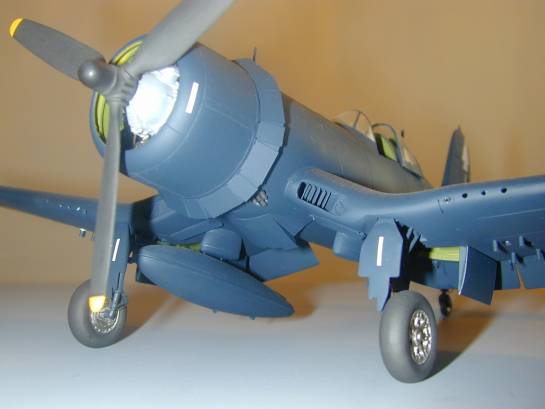
Engine
At the time I started this project, I was able to convince Engines and Things that a 1/32 scale engine is desperately needed for this model. It was agreed and a beautiful R-2800 was cast that even included the proper mags for an F4U-1D! Push rod tubes were added from plastic rod and an ignition harness was also added from brass wire. This would also address the problem of having the kit engine extend to far forward from the cowling. The great thing about this aftermarket engine is that it simply mounts to the existing kit firewall with no modifications required. The kit prop is for an F4U-1A so I cannibalized the prop from an F6F and added it to the model to accurately represent that for the F4U-1D. The exhaust system was the next item to be fixed and this was made from solder and superglued into place.
Cowling
The cowl flaps are a major problem on this kit. On the F4U-1D, the cowl flaps are not all the same size as portrayed in the kit. They actually alternate in size which can be clearly seen in photos. I removed the kit cowl flaps and made new ones from plastic card. I added to the backside of the cowl flaps the cable operating system which is also evident in photos.
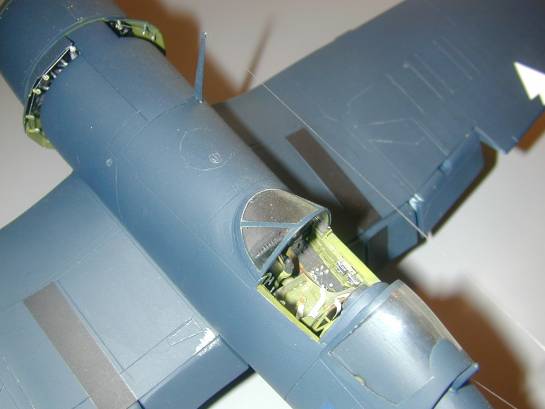
Fuselage
Starting just aft of the firewall I opened up the intercooler flap on the underside. Also added here is brass exhaust stacks. Moving further aft is the cockpit. Using a Marine Air Products set and Eduard photoetch, I scratchbuilt an acceptable interior. The only satisfactory items I used from Eduard is the seat and instrument panel. A new seat harness was added made from paper. The sidewalls and rear bulkhead came from Marine Air Products and with the new detail sets just released I can't recommend this detail set to anyone. Go out and purchase the Black Box or Lone Star Productions sets and you will be much further ahead. Additionally, a gunsight was then added from Insight Details. I find these gunsights to be superb and go a long way to adding that little extra essential to a cockpit! As the F4U-1D that I was building was a later variant the canopy was sanded and polished to remove the overhead canopy frame.
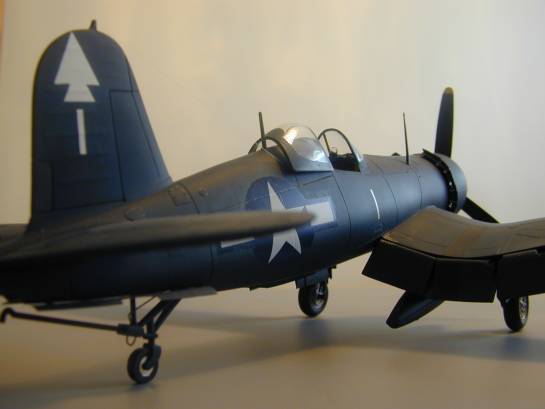
Empennage
Access covers are now added to this area of the aircraft. I decided to leave the control surfaces in the neutral position. Balance and trim tab actuators are now attached. The tail wheel well is now boxed in. Control cables and torque tubes are then added inside the wheel wells. Attention is now paid to the tail wheel strut. It is detailed with tie down hooks and other assorted items.
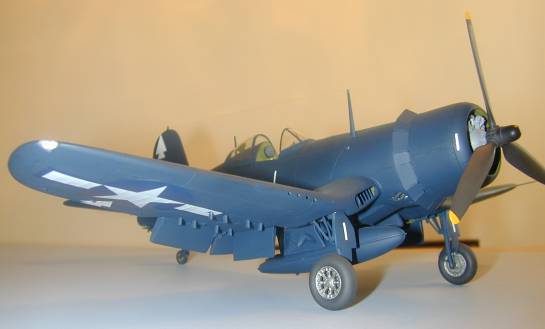
Wings
This turned out to be the largest part of the project to date. Of course the flaps have to be dropped. The flaps were cut out and new items made from plastic tubing and card. The step in the flap was filled in as references dictate. Lone Star Productions have now come out with a flap set thankfully. Servo and trim tab actuators are added to the ailerons at this time. New leading edge intakes are now fashioned from plastic card, brass screen and glued into place. Strip styrene is used at the wingroot by attaching two strips to the wingroot at right angles. This fairing is something you see in reference photos and also serves to hide the wing to fuselage joint. The wheel wells are boxed in with various details added.
New landing gear doors are made from plastic card. Wood is used to build up the gear door structure. First glue a piece of balsa strip to a piece of plastic card cut to the shape of the outer gear door surface. Ensure that the balsa wood is just slightly smaller. Sand the balsa to the proper inside taper shape. Attach another piece of card to the inner surface of the gear door effectively sandwiching the balsa between two pieces of styrene. Check your references and you will notice when looking at the gear doors from head-on that they are not flat as portrayed in the kit but are tapered toward the bottom of the gear door. Then use a Dremel tool and grind in the various depressions in the doors and sand smooth. Gear door hinges are then made from styrene strip which allow the doors to hang slightly off the bottom surface of the wing. Once again, Lone Star has come to the rescue in this area by offering its new landing gear set specifically designed for the kit.
While robbing F6F parts, I decided that the wheels would look good on the Corsair. These now replace the kit supplied wheels and sit on fully detailed gear legs. Rocket rail mounts and underwing pylons are added to the wing underside as is a beautiful drop tank supplied by Engines and Things. Gun camera lenses are added to the leading edge of the wing as is the prominent stall strip an the right side. The stall strip is also peculiar to the F4U-1D. A pin acts as the pitot tube.
Finish
I chose the markings for Major Herman Hanson of VMF-112 onboard the USS Bennington, Feb 1945. As all tactical markings would be made on white decal paper, this would be an easy scheme to portray. The aircraft was then painted using Floquil paints. I find their line of paint to be excellent and very easy to spray with my Badger or Paasche single action airbrush. No masking is required of course do to the overall blue scheme.
As this aircraft is only lightly weathered, I decided to use a silver drafting pencil to just lightly scruff up and scratch some of the surface detail. I wanted to portray the aircraft as a new comer to the front lines. The insignia are the kit supplied items which reacted very well to decal setting solution. The tactical markings are just scaled up items from Aeromaster. Using dividers and a ruler, the markings are drafted on to white decal paper and then cut out. To finish the kit, antenna rigging was added and the model is now complete.
Overall, this was a HUGE project that took lots of time but I think the end result accurately portrays the power of the Bent-Wing Bird.
© Mark Proulx
This article was published on Wednesday, July 20 2011; Last modified on Monday, July 02 2018
